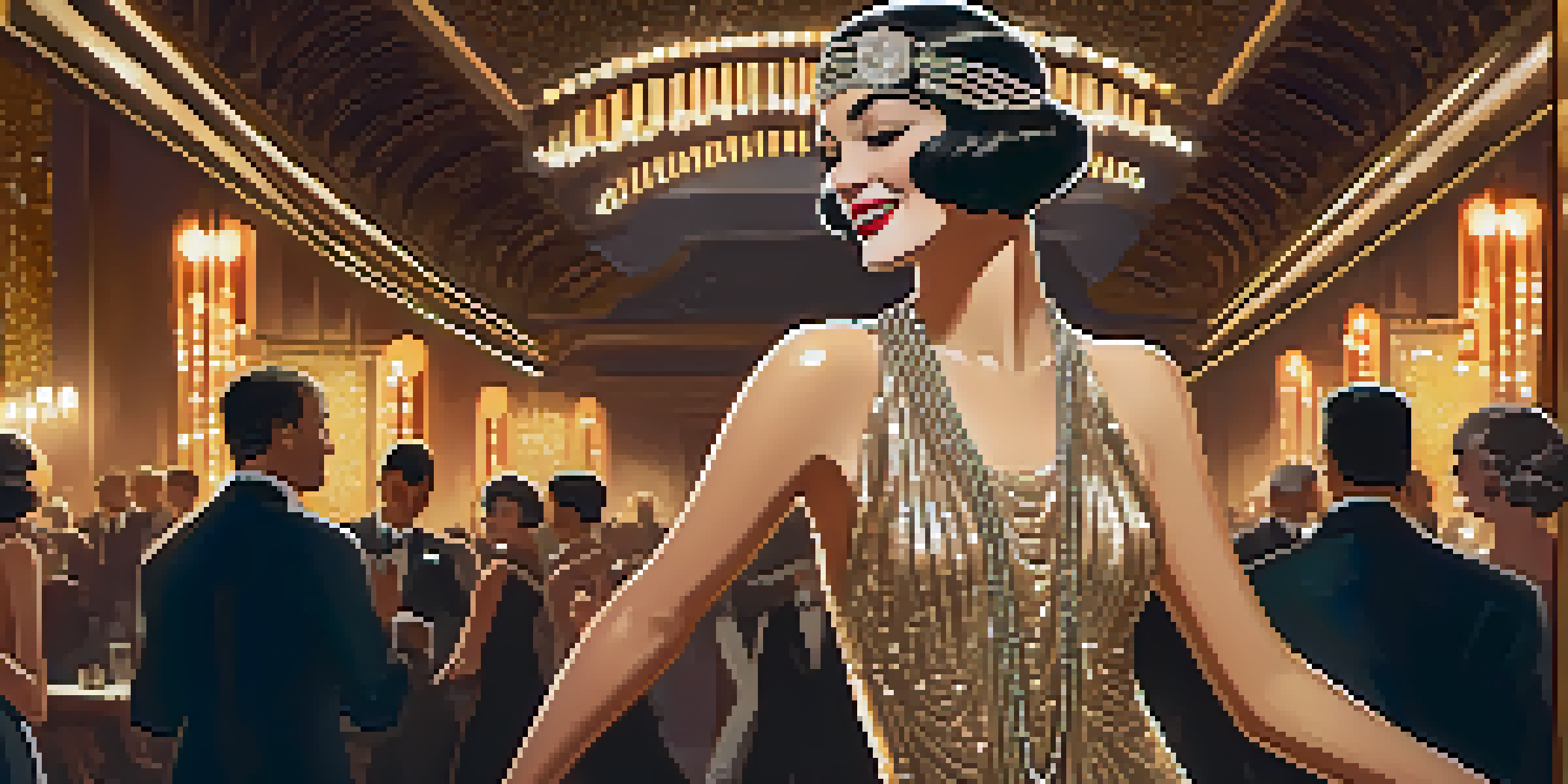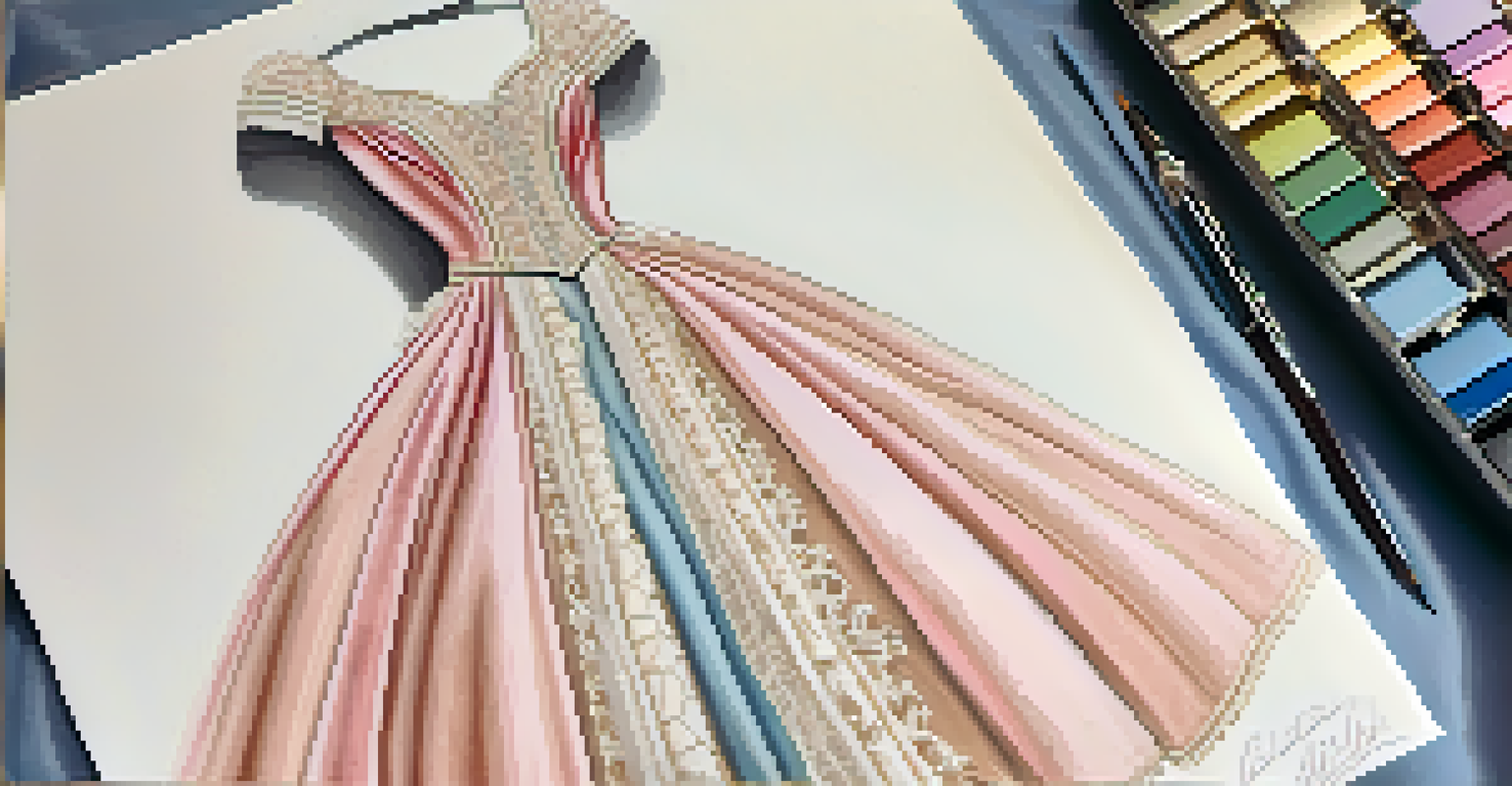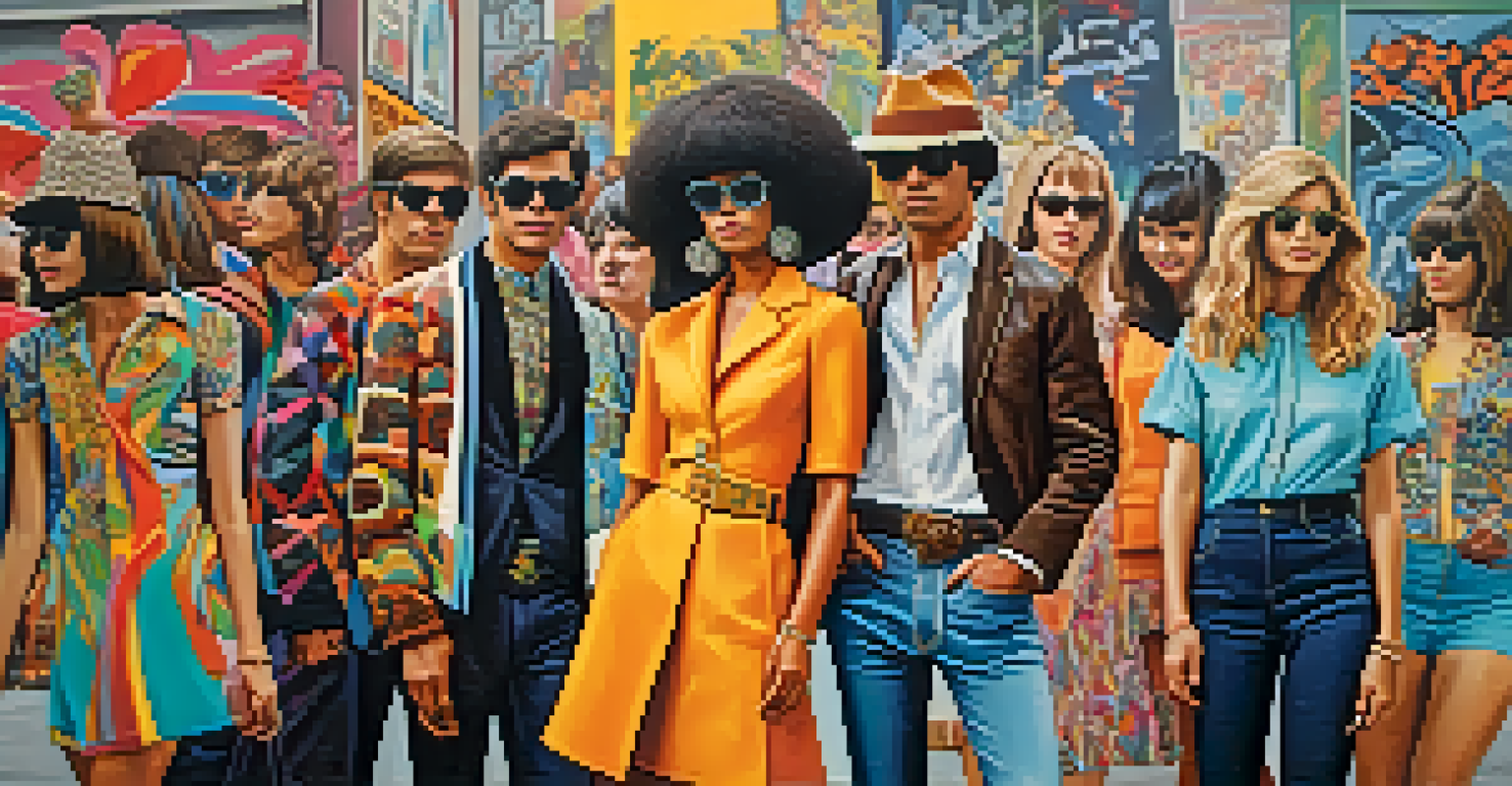The Evolution of Fashion in Early Cinema: A Historical Overview

The Birth of Cinema: Fashion in the Silent Era
The early years of cinema, particularly in the silent film era, were marked by a distinct style of fashion that reflected the social norms of the time. Actors and actresses donned elaborate costumes that not only highlighted their characters but also mirrored the fashion trends of the 1910s. This was a time when the wealthy flaunted their status through luxurious fabrics and intricate designs, setting a standard for audiences to aspire to.
Fashion is the armor to survive the reality of everyday life.
Costume designers played a pivotal role in shaping the visual narrative of silent films. They employed rich fabrics, bold patterns, and sometimes even exaggerated silhouettes to convey emotions and themes without spoken dialogue. For instance, a flowing gown might signify a character's grace, while a sharply tailored suit could denote authority and power.
Moreover, the reliance on visual storytelling meant that fashion became a language of its own. Viewers were captivated not just by the plot but also by the glamorous and sometimes fantastical clothing that adorned their favorite stars. This interplay between fashion and film laid the groundwork for the evolution of style in cinema.
The Roaring Twenties: Fashion Takes Center Stage
As the 1920s roared in, so did significant changes in both culture and fashion. The advent of sound in films brought a new vibrancy to the industry, and fashion became even more central to cinematic storytelling. Iconic films of this era showcased flapper dresses, bobbed hairstyles, and dapper suits, embodying the spirit of liberation and rebellion that defined the decade.

Stars like Clara Bow and Rudolph Valentino became fashion icons, influencing trends far beyond the silver screen. Their on-screen wardrobes were meticulously crafted to reflect the era's boldness, with shimmering sequins and daring cuts that encouraged audiences to embrace their own sense of style. As a result, cinema began to impact real-world fashion choices more directly than ever before.
Fashion Mirrors Societal Changes
Throughout cinema's history, fashion has reflected the evolving social norms and cultural attitudes, showcasing how clothing conveys messages about identity and resistance.
This period also marked the rise of Hollywood as a cultural powerhouse, where glamour and style were synonymous with stardom. With fashion magazines starting to feature movie stars prominently, the connection between cinema and fashion solidified, making it clear that what was worn on screen could dictate trends in everyday life.
The Golden Age of Hollywood: A Showcase of Elegance
The Golden Age of Hollywood, spanning the 1930s to the 1950s, is often celebrated for its opulent fashion that defined an era. This was the time when studios employed skilled costume designers like Edith Head, whose creations became legendary. Films like 'Gone with the Wind' showcased sumptuous dresses that became instantly iconic, elevating fashion to a central narrative element in storytelling.
Clothes mean nothing until someone lives in them.
During this era, the portrayal of characters through fashion became more nuanced. Costumes were designed not just for aesthetics but to reflect the character's journey and personality. For example, a character’s transformation could be illustrated through evolving wardrobe choices, symbolizing their growth or change throughout the film.
Additionally, the impact of film on fashion was further amplified by the rise of the fashion show, where designers sought inspiration from cinematic styles. The glamour of Hollywood was translated onto the catwalk, creating a reciprocal relationship between film and fashion that resonated with audiences and consumers alike.
The 1960s and 1970s: Cultural Shifts Reflected in Fashion
The 1960s and 1970s heralded a wave of social change, and cinema mirrored these shifts through revolutionary fashion choices. The mod movement brought bold patterns, striking colors, and youthful exuberance to the forefront. Films like 'Breakfast at Tiffany's' showcased the chic styles of the time, influencing both fashion trends and cultural attitudes.
As the counterculture movement gained momentum, so did a more relaxed and eclectic approach to fashion in films. Characters in movies began to reflect a broader spectrum of identities, with styles ranging from bohemian to punk, demonstrating an embrace of individuality and self-expression. This shift highlighted the idea that fashion could be a form of rebellion against traditional norms.
Iconic Styles Shape Cultural Trends
From the flapper dresses of the 1920s to the bold patterns of the 1960s, film fashion has not only influenced audience trends but also established cinema as a cultural powerhouse.
During this period, stars like Audrey Hepburn and Jane Fonda became symbols of style that resonated with the younger generation. Their outfits were not just costumes but statements that encapsulated the spirit of the times, making fashion an integral part of cinematic storytelling and cultural commentary.
The Influence of Fashion Designers in Cinema
As cinema progressed into the 1980s and beyond, the collaboration between filmmakers and fashion designers became increasingly prominent. Renowned designers like Gianni Versace and Yves Saint Laurent recognized the potential of film as a platform for showcasing their creations. This partnership led to visually stunning films that highlighted fashion as a key element of storytelling.
Movies began to feature wardrobe choices that were as impactful as the scripts themselves. Films such as 'The Devil Wears Prada' showcased the fashion industry, providing a behind-the-scenes look at the creative process while highlighting the importance of style in everyday life. This connection between film and fashion created a thriving dialogue between the two art forms.
Furthermore, the rise of product placement in films allowed luxury brands to gain visibility among audiences. This strategy not only enhanced the cinematic experience but also solidified the relationship between the fashion industry and Hollywood, making it clear that what viewers saw on screen could influence their own purchasing decisions.
Fashion as a Reflection of Societal Changes
Throughout cinema's evolution, fashion has consistently reflected societal changes and cultural attitudes. From the opulence of the 1930s to the rebellious styles of the 1960s, each era's fashion choices were deeply intertwined with the social issues of the time. This relationship illustrates how clothing can convey messages about identity, class, and resistance.
As filmmakers tackled themes of social justice and equality, fashion also began to evolve in response. For instance, films addressing race and gender issues highlighted the importance of authenticity in representation, leading to a more diverse portrayal of fashion that appealed to a broader audience. This shift allowed for greater inclusivity and recognition of different cultural styles.
Future Trends Embrace Sustainability
As digital technology and eco-consciousness rise, the future of fashion in cinema is set to explore innovative storytelling while prioritizing sustainable practices.
Ultimately, the evolution of fashion in cinema serves as a mirror to society, showcasing how art reflects life. By examining the fashion choices of characters, audiences can gain insights into the cultural context of each film, enhancing their understanding of the societal dynamics at play during various historical periods.
The Future of Fashion in Cinema
As we look to the future, the relationship between fashion and cinema continues to evolve in exciting ways. With the rise of digital technology and social media, filmmakers have new platforms to explore innovative fashion concepts. Virtual fashion shows and collaborations between film and fashion brands are becoming increasingly popular, allowing for more dynamic storytelling.
Moreover, sustainability is becoming a key consideration in both industries. As awareness of environmental issues grows, filmmakers and fashion designers alike are exploring eco-friendly materials and practices, reflecting a collective desire for change. This shift not only impacts the fashion seen on screen but also influences audience perceptions and choices in real life.

Ultimately, the future of fashion in cinema promises to be as diverse and innovative as the stories being told. As filmmakers continue to break boundaries and challenge norms, fashion will remain an essential component of cinematic storytelling, reflecting the ever-changing landscape of culture and society.